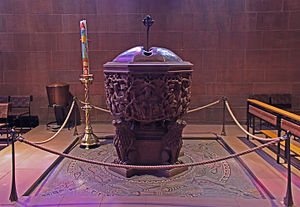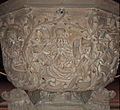Font of the Worms Cathedral
The late Gothic baptismal font in Worms Cathedral was built between 1484 and 1488. It is considered a model for the so-called lion baptismal font in the area of the former diocese of Worms . The sandstone baptismal font originally stood in the Johanneskirche in Worms , which served as a baptistery . After its demolition in the 19th century, it was moved to the St. Nicholas Chapel of the cathedral .
layout
The head-high (1.65 m) baptismal font follows the shape of a chalice, which was modern since the mid-15th century: base plate, base, shaft and cup.
The simple, square base rises above an octagonal, alternately protruding and recessed base plate. Four lion figures sit on the protruding parts of the base plate. At the level of the mane, the base jumps back like a staircase, tapers and thus forms the shaft. Above it rises the huge, also octagonal cup, which also rests on the heads of the lions. The four lions are alert and ready to jump, but shown with a friendly expression.
Springs from the shaft, yet abstract, branches to pull over the cuppa and to divide it into eight fields. In the fields there are semi-sculptural representations of John the Baptist and seven other people from the Old Testament with banners . The other persons shown are: David , Jesus Sirach , Ezekiel , Isaiah , Zechariah , Jeremiah and Joel . The top of the cup is formed by a profile designed with grooves and webs.
Kuppa (walked counterclockwise):
Style and model of the lion baptismal font
The chalice shape was already common at the time of creation, but there were differences in the artistic design. Otto Böcher differentiates (roughly summarized) between the tracery type (lily MT and fish bladder MT) and the branch type . The lily tracery type is more likely to be found in the greater area of the diocese of Mainz, the fish bladder tracery type in that of the diocese of Worms. Both types of design, with tracery and branch work , appeared around the same time, but independently of one another, and were carried out in the following years up to the end of the first quarter of the 16th century.
The model for all types of branches is the baptismal font of the Worms Cathedral, the novelty of which is the multi-twisted, rope-like grooved branches that adorn it from the shaft over the cup. As a result, its structure and style are characteristic of a whole series of other baptismal fonts , the so-called lion baptismal fonts , in the region of the former diocese of Worms in the late 15th and early 16th centuries. Böcher shows a total of 25 baptismal fonts influenced by the Worms font, with the fonts in Guntersblum , Sausenheim and Colgenstein following the Worms model most closely. The design in Rüssingen , Kleinbockenheim , Rodenbach , Quirnheim and Mertesheim was varied more .
literature
- Otto Böcher : The development of the Löwentaufstein in the Hessian and Rhine-Franconian Gothic. In: Der Wormsgau , Volume 5, Worms 1961/62, pp. 31-84.
- Stefanie Meier-Kreiskott: Late Gothic baptismal fonts in the German southwest. Munich 2011 (dissertation; online )





